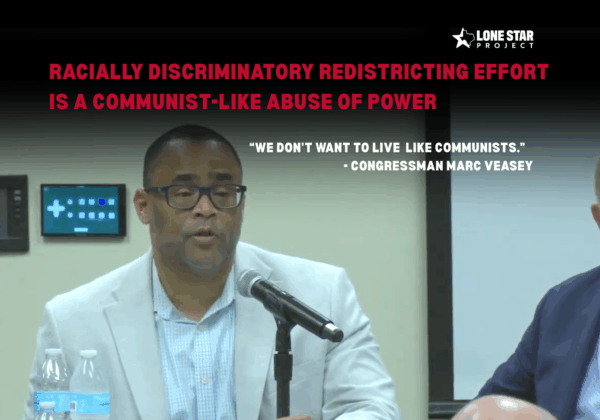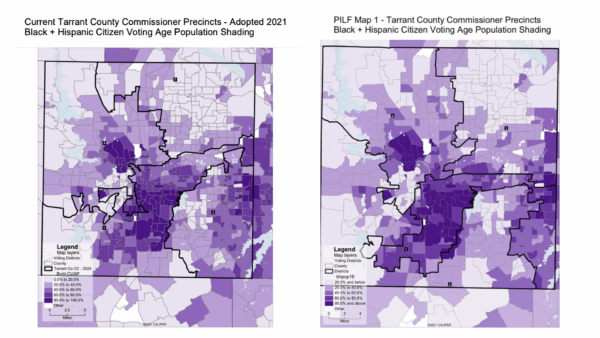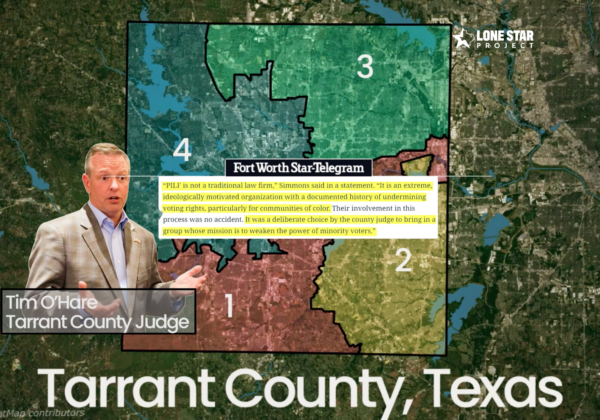While the Supreme Court’s Texas decision was split 5/4, included six separate opinions and over 132 pages of text, the bottom line is clear:
- The Court did not step in to halt mid-decade redistricting; There is virtually no conceivable circumstance in which the Court will find illegal partisan gerrymandering;
- Regardless of whether African Americans repeatedly demonstrate political control of a district, their voting rights will not be protected unless their voting age population in the district is at or near a raw majority; and
- Hispanic districts with a clear majority of registered voters and demonstrating the potential ability to elect the candidate of their choice will continue to be protected.
The following Lone Star Project analysis is divided into two parts. Part One deals with plaintiff claims the Supreme Court rejected. Part Two looks at some various map options that may be offered to the Federal District Court
Part One
Green Light to Mid-Decade Redistricting
The Court refused to block mid-decade redistricting. The Court disagreed with the Jackson Plaintiffs who argued that mid-decade redistricting is illegal when the sole purpose is partisan gain and with the Travis County Plaintiffs who argued that mid-decade redistricting violated the one person-one vote principle because the census information used was outdated. The result of the Court’s opinion is that any state or locality, for solely political reasons, may engage in mid-decade redistricting to take advantage of, or to head-off, a change in the political fortunes of one party or the other.
Partisan Redistricting – It Quacks and Waddles, But It’s Not a Duck
While acknowledging that the sole purpose and ultimate result of the Republican redistricting effort in Texas was to guarantee the election of Republicans at the expense of Democrats, the Court refused to find illegal partisan gerrymandering. Most observers agree with the Washington Post’s opinion that although the Court, “again formally leaves open the question of whether any gerrymander could be bad enough to warrant judicial intervention. But if Texas’s case is not bad enough, then the one that is can exist only in some place other than the real world.” (Source: The Washington Post, Editorial, July 5, 2006)
African Americans Voting Rights Discounted
The Court was unmoved by the detailed analysis conducted by both Republican and Democratic experts that demonstrated African Americans in a Fort Worth based congressional district (CD24) had consistently demonstrated that they dominated and controlled the Democratic primary and that their candidate of choice always won the General Election. Instead, the Court cited that the District was only 21 percent voting age African American and relied on non-expert witness testimony. Specifically, they used the comments of now defeated African American former State Representative Ron Wilson who worked with Republicans throughout the redistricting effort. They also took a comment made by Congresswoman Eddie Bernice Johnson out of context to justify their decision. Congresswoman Johnson’s quote was actually made when commenting about a different district in an earlier plan and NOT the district and plan that was before the Court.
Part Two
South Texas Map Scramble
The Supreme Court struck down Congressional District 23, represented by Henry Bonilla, ruling that the Republican Legislature violated the Voting Rights Act when it removed over 100,000 Hispanics from CD23 reducing its voting age Hispanic population from 63 percent to only 50.9 percent (source: Texas Legislative Council) and attempted to replace the district with a newly drawn Hispanic CD25 now represented by Lloyd Doggett. The Court ruled that Hispanic voting strength in CD23 was reduced in order to protect Henry Bonilla and that CD25 was not sufficiently compact to serve as a “replacement” Hispanic district. The Court has ordered all parties to the suit to present their proposed maps by July 14, 2006.
A scramble is now underway among Republicans representing the State of Texas, Members of Congress and Hispanic advocacy groups to construct a newly drawn plan. Each has their own priorities which will be reflected in their submissions to the Court. Below are some approaches we can expect to see.
Key Target Figures to look for in CD23
The Court determined that Hispanic Voting strength was sapped in CD23 just as Hispanics were on the verge of controlling the District. With this in mind, it is reasonable to suppose that the District Court will require that any remedy to CD23 restore its Hispanic percentages to their previous levels. They were as follows:
- Total Hispanic Population – 66.8%
- Voting Age Hispanic Population – 63.0%
- Citizen Voting Age Population – 57.4%
- Percentage Hispanic Registered Voter – 55.3%
Further, the District Court may not accept any map that materially reduces these key racial numbers in any of the other Voting Rights protected Districts in South Texas which are CD15 (Hinojosa), CD16 (Reyes), CD20 (Gonzalez), CD28 (Cuellar).
Potential Re-Map Options
Under a precedent set in the Supreme Court case Upham v. Seamon, the District Court is required to impose a “narrowly tailored” remedy, which requires that any new map (remedy) be limited to correcting the violation of law the Court has found. With this in mind, the options described below are those that would impact relatively few districts. It is assumed that options rippling across the entire State, or far outside South Texas, will not be seriously considered by the District Court.
All of Webb County into CD28 Option
- All of Webb County would be moved into CD28 (Cuellar).
- The Hispanic population in CD23 (Bonilla) would be increased by moving West Texas Hispanics currently in CD11 (Conaway) and Bexar County Hispanics in CD28 (Cuellar) into CD23.
- This also may require population shifts within Bexar County involving CD20 (Gonzalez).
- Hill Country Republicans currently in CD23 would move to CD11 (Conaway).
- This option may, or may not, include changes in CD25 (Doggett).
Who might support? This option may be favored by Henry Cuellar and some congressional Republicans because it would increase Cuellar’s Webb County base, would not “pair” Bonilla with Cuellar, and it would add relatively low turnout West Texas and Bexar Hispanics to CD23, thus presenting less of a threat to Bonilla.
Who might oppose? Conaway and Texas House Speaker Tom Craddick, may object to significant changes to CD11, especially the deep cuts into Ector and Midland Counties that might be required under this option. Also, if map drawers attempt to shift population in Bexar County and impact CD20 (Gonzalez), then Gonzalez may object.
Cautionary Note: CD20 (Gonzalez) is a Voting Rights protected district. Any shifts in population that result in lower Hispanic percentages may not be accepted by the Court.
All of Webb County to CD23 Option
This option most directly addresses the specific concerns of the Supreme Court
- Webb County in its entirety would return to Bon illa’s 23rd District.
- CD28 (Cuellar) would, in turn, pick up new Hispanic voters in Hidalgo and other nearby S. Texas Counties from CD25 (Doggett).
- CD25 would shift northward picking up voters in and around Travis County from CD21 (L. Smith).
- CD21 (L. Smith) would reclaim Republican Hill Country Counties currently in CD23.
Who might support? Travis County plaintiffs would likely support the notion of creating a clearly Austin-based district as this option would do. Also, Democrats who have been disappointed and often angered by Cuellar’s consistent support for President Bush, Governor Perry, and Republican House initiatives will like the idea of moving Cuellar’s base out of CD28, leaving it open for a more trustworthy Democrat. Finally, Hispanic advocacy organizations might favor an option that clearly returns the Hispanic voting strength that was removed from CD23, while addressing the Court’s concerns about CD25 compactness.
Leave Districts 28 and 25 Alone Option
Some believe that because the Supreme Court did not specifically direct that CD25 (Doggett) or CD28 (Cuellar) must be changed, that a map may be accepted that leaves them unchanged. This line of thought asserts that the Court simply directed that CD23 (Bonilla) be restored as a Hispanic opportunity district. It is possible to enhance the Hispanic population in CD23 without disturbing the current boundaries of CD28 or CD25.
- Move Hispanics from CD11 (Conaway) into CD23.
- Replace CD11 population with Hill Country and other West Texas Anglos now in CD23.
- Shift population within Bexar County between CD23, CD20 (Gonzalez) and CD21 (L. Smith) to increase the overall Hispanic population of CD23.
Who might support? Congressional Republicans and Bonilla might see this as a better option than moving all of Webb back into CD23. Cuellar would also like the idea of CD28 remaining a Webb based district, not being “paired” with Bonilla and not facing a new primary. Some Hispanic advocacy groups might like the idea of CD23 being enhanced while also maintaining a heavily Hispanic CD25 (Doggett), which would leave seven rather than six majority Hispanic Districts that are S. Texas based.
Who might oppose? Charlie Gonzalez would not want to be embroiled in correcting a problem he has skillfully avoided. It is important to note that Gonzalez’s district 20 is a Voting Rights Act protected district and thus Hispanic voting strength cannot be reduced to any significant degree. Also, Travis County would like changes to be made in CD25 that would return it to an Austin-based District. Finally, the District Court may be leery of ordering a map that leaves CD25 untouched since the Supreme Court stated that it was not “sufficiently compact” to be considered an effective Hispanic district and indicated CD25 would likely change as a result of remedying the voting discrimination against Hispanics that the Republican Legislature did in dismantling District 23.
Cautionary Note: CD20 (Gonzalez) is a Voting Rights protected district. Any shifts in population that result in lower Hispanic percentages may not be accepted by the Court.
Hinojosa Option
Many Democrats and some Hispanic advocacy groups remain concerned that Hispanic voting strength in CD15 (Hinojosa) was significantly weakened under the current Republican-drawn map. Hispanic voting age population in the CD15 was reduced from 74.3 percent to 64 percent. In reviewing the plan, voting rights experts in the Department of Justice specifically noted that Hispanic voting strength in CD15 had been reduced to the point that it may not consistently perform as an effective Hispanic District. (Source: DOJ Section 5 Recommendation Memorandum, December 12, 2003)
An option to correct this would:
- Move all of Webb County into CD23 (Bonilla).
- Move some of the Hidalgo County population now in CD25 (Doggett) into CD28 (Cuellar).
- Shift the remaining Hidalgo County population into CD15 (Hinojosa).
- Contract (CD25) to the North and absorb new population in and around Travis County now in CD10 (McCall) and perhaps CD21 (L. Smith).
- Rural counties to the north currently in CD15 would move into CD10 (McCall). GOP Hill Country counties now in CD23 would move to CD21 (L. Smith).
Who might support? Hidalgo County and Ruben Hinojosa may favor this type of solution. Also, Democrats who are concerned about the long-term viability of CD15 might like the idea.
Who might oppose the plan? Both Cuellar and Bonilla would likely oppose this approach. Also, those who are concerned that this approach does not meet the “narrowly tailored” requirement.
Will the Remedy Be Enforced in 2006?
While it is not unprecedented for the Court to allow an election to go forward before correcting a Voting Rights Violation, doing so is unusual. Most observers expect that the Court will order its remedy enforced in the 2006 election.
Texas Precedent
The precedent in Texas was set in 1996, when a three-judge Federal District Court ruled that three Texas Districts were unconstitutional and ordered a remedy that changed a total of 13 of 30 districts. Under this scenario:
- The Court would vacate the already conducted 2006 primary in effected districts and order an “open” or “Louisiana Style” primary wherein all candidates from either party file and run together on the same ballot.
- The primary would take place on the General Election date parallel to the regular General Election.
- In any district in which one candidate does not garner more than 50 percent of the vote, a run-off is held 30 days later involving the top two finishers.
- In 1996, Nick Lampson (CD9), Ken Bentsen (CD25) and Kevin Brady (CD8) were elected to Congress in December run-offs.
- An important note to remember is that under this scenario “straight-ticket” votes would not be recorded in the congressional races. Voters who cast a “straight ticket” ballot would have to also mark their specific preference for Congress.



